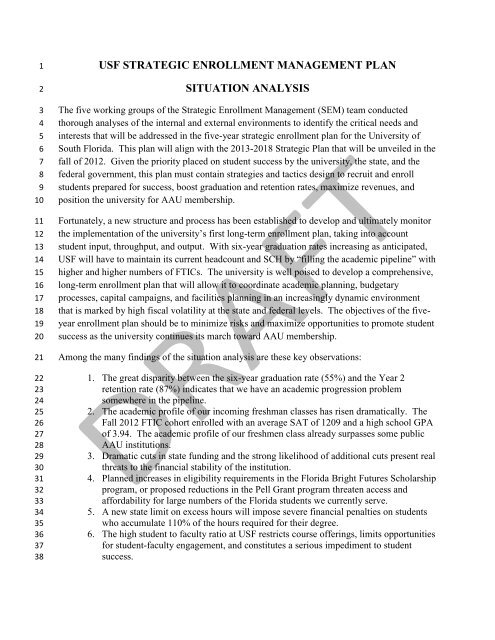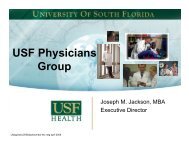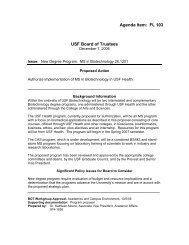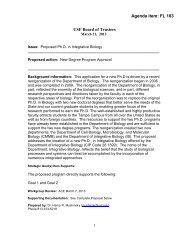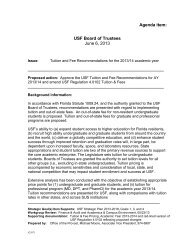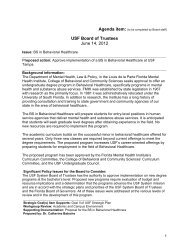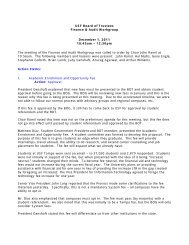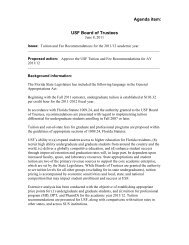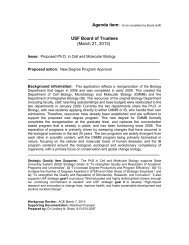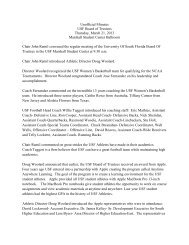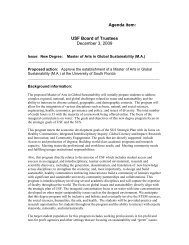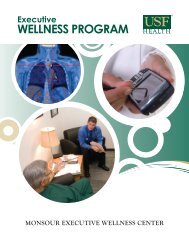Strategic Enrollment Management Situation Analysis - University of ...
Strategic Enrollment Management Situation Analysis - University of ...
Strategic Enrollment Management Situation Analysis - University of ...
Create successful ePaper yourself
Turn your PDF publications into a flip-book with our unique Google optimized e-Paper software.
1234567891011121314151617181920212223242526272829303132333435363738USF STRATEGIC ENROLLMENT MANAGEMENT PLANSITUATION ANALYSISThe five working groups <strong>of</strong> the <strong>Strategic</strong> <strong>Enrollment</strong> <strong>Management</strong> (SEM) team conductedthorough analyses <strong>of</strong> the internal and external environments to identify the critical needs andinterests that will be addressed in the five-year strategic enrollment plan for the <strong>University</strong> <strong>of</strong>South Florida. This plan will align with the 2013-2018 <strong>Strategic</strong> Plan that will be unveiled in thefall <strong>of</strong> 2012. Given the priority placed on student success by the university, the state, and thefederal government, this plan must contain strategies and tactics design to recruit and enrollstudents prepared for success, boost graduation and retention rates, maximize revenues, andposition the university for AAU membership.Fortunately, a new structure and process has been established to develop and ultimately monitorthe implementation <strong>of</strong> the university’s first long-term enrollment plan, taking into accountstudent input, throughput, and output. With six-year graduation rates increasing as anticipated,USF will have to maintain its current headcount and SCH by “filling the academic pipeline” withhigher and higher numbers <strong>of</strong> FTICs. The university is well poised to develop a comprehensive,long-term enrollment plan that will allow it to coordinate academic planning, budgetaryprocesses, capital campaigns, and facilities planning in an increasingly dynamic environmentthat is marked by high fiscal volatility at the state and federal levels. The objectives <strong>of</strong> the fiveyearenrollment plan should be to minimize risks and maximize opportunities to promote studentsuccess as the university continues its march toward AAU membership.Among the many findings <strong>of</strong> the situation analysis are these key observations:1. The great disparity between the six-year graduation rate (55%) and the Year 2retention rate (87%) indicates that we have an academic progression problemsomewhere in the pipeline.2. The academic pr<strong>of</strong>ile <strong>of</strong> our incoming freshman classes has risen dramatically. TheFall 2012 FTIC cohort enrolled with an average SAT <strong>of</strong> 1209 and a high school GPA<strong>of</strong> 3.94. The academic pr<strong>of</strong>ile <strong>of</strong> our freshmen class already surpasses some publicAAU institutions.3. Dramatic cuts in state funding and the strong likelihood <strong>of</strong> additional cuts present realthreats to the financial stability <strong>of</strong> the institution.4. Planned increases in eligibility requirements in the Florida Bright Futures Scholarshipprogram, or proposed reductions in the Pell Grant program threaten access andaffordability for large numbers <strong>of</strong> the Florida students we currently serve.5. A new state limit on excess hours will impose severe financial penalties on studentswho accumulate 110% <strong>of</strong> the hours required for their degree.6. The high student to faculty ratio at USF restricts course <strong>of</strong>ferings, limits opportunitiesfor student-faculty engagement, and constitutes a serious impediment to studentsuccess.
12345678910111213141516171819202122232425262728293031323334353637383940417. Undergraduate enrollment is currently concentrated at the upper level. Graduateenrollment is concentrated at the Grad I level.8. Faculty contributions to the overall undergraduate student experience are not valuedas much as research and scholarship.9. The absence <strong>of</strong> an integrated, university-wide branding and marketing effort placesUSF at a competitive disadvantage in undergraduate and graduate recruitment efforts.10. Campus life and culture is not yet active or vibrant enough to attract and retain topnotchfaculty, staff, or students.11. Our current housing inventory is not sufficient in quality or capacity to supportsignificant increases in FTIC enrollment or an expansion <strong>of</strong> the on-campus residencyrequirement.12. The use <strong>of</strong> real-time, actionable intelligence by students, staff, or faculty to promotestudent success efforts is limited.Internal Strengths1. The <strong>University</strong> <strong>of</strong> South Florida has made a definite commitment to Student Success anddemonstrated it by investing recurring funds to support initiatives sponsored or initiated by theStudent Success Council, including but not limited to:The SMART LabPr<strong>of</strong>essional AdvisorsTutoring and Learning ServicesCareer Counseling2. Our campus climate has improved dramatically in the last few years, but there iswidespread recognition that we can still create a more vibrant campus culture.Investments in the physical environment and student engagement have improved thestudent experience.80% <strong>of</strong> Bachelor degree candidates have expressed satisfaction with their collegeexperience.According to the 2010 admitted student survey, students perceive USF as being“Friendly, Research Oriented, Fun and Comfortable” compared to UF, FSU, and UCF.The number <strong>of</strong> student organizations now exceeds 600, providing more opportunitiesthan ever for students to get involved on campus and in the community.Student engagement on campus has increased significantly, beginning with a vigorousOrientation and Week <strong>of</strong> Welcome activities, followed by diverse programmingthroughout the year.Dedicated spaces for different student populations (Skylab, commuter lounge, courtyardspace) and more lounge space for interaction have created “life” on campus.3. The institutional focus on building research excellence is beginning to permeate theundergraduate experience.
12345678910111213141516171819202122232425262728293031323334353637A top 50 national ranking in research has brought greater recognition to the universityand should help recruit students with even stronger academic credentials.A centrally located Office <strong>of</strong> Undergraduate Research promises to spread researchopportunities across the colleges4. The cost <strong>of</strong> attendance for undergraduate students is among the lowest in the nation.Annual tuition <strong>of</strong> $5,806 at USF compares favorably with the national average <strong>of</strong> $8,254.In comparison to the costs <strong>of</strong> attendance at AAU institutions, USF represents a significantvalue in higher education.5. The 1 st year undergraduate residency requirement and the creation and expansion <strong>of</strong>Living Learning Communities are transforming campus life and supporting student successinitiatives.Student interest in Living Learning Communities remains strong and new ones are beingcreated.National studies show that living on campus contributes to retention and satisfaction.6. On-campus student employment has increased, due in part to a deliberate campaign topromote on-campus opportunities in support <strong>of</strong> student success.National research studies have demonstrated a positive correlation between on-campusstudent employment and student success rates.7. The construction <strong>of</strong> new facilities and the renovation <strong>of</strong> some older buildings hasimproved the teaching and learning environment.New buildings, such as the Marshall Student Center, the Patel Center for GlobalSolutions, the Interdisciplinary Science Building, and Juniper-Poplar, have created anattractive campus.Renovations to existing facilities, including the Sun Dome, the <strong>University</strong> Library, andCooper hall, have greatly improved the teaching and learning environment.76.9% <strong>of</strong> Bachelor Candidate students agreed that USF is an attractive campus.8. The institutional commitment to veteran support is nationally recognized.USF was ranked as the 5 th best veteran-friendly institution in the country.Since the passage <strong>of</strong> the Post-9/11 GI bill in 2008, the enrollment <strong>of</strong> veterans hasincreased 40%.There are 1,600 veterans and dependents currently seeking undergraduate and graduatedegrees.
12345678910111213141516171819202122232425262728293031323334353637389. The institutional focus on global affairs has created greater opportunities to market theglobal character <strong>of</strong> the university.The <strong>University</strong> has a long-term contract with INTO and its international recruiting teamto increase the number <strong>of</strong> full-fee paying international students on campus.USF World, Programs in Office <strong>of</strong> Multicultural Affairs, Education Abroad, InternationalAlternative Spring Breaks, INTO, Global Citizenship General Education Program, andthe international faculty population can be used more effectively in recruiting andmarketing.The Tampa Bay area represents a strong competitive advantage in recruiting, marketing,and enrollment efforts.10. Improvements in policies and practices regarding the first-year student experience haveimproved retention rates.The Year 1 to Year 2 retention rate rose from 81.6% (2001 cohort) to 87% (2011 cohort),Several <strong>of</strong>fices focused on 1 st year student support (Orientation, FSI/SSI, New StudentConnections) are contributing to high retention rates.Other practices and policies, including a 1 st year academic advising hold and 1 st year midtermgrades, are also producing results.Increasing the retention rate to 90% would place USF among a selective group <strong>of</strong>institutions in the country.11. The academic pr<strong>of</strong>ile <strong>of</strong> our incoming freshman classes has risen dramatically and itcontinues to rise.The Fall 2011 class entered with an average SAT score <strong>of</strong> 1203 and a GPA <strong>of</strong> 3.91.The Fall 2012 FTIC academic pr<strong>of</strong>ile improved to an average SAT score <strong>of</strong> 1209 and aGPA <strong>of</strong> 3.94The Summer 2012 FTIC academic pr<strong>of</strong>ile also improved from an average SAT <strong>of</strong> 1075 to1091.Taken together, the Summer/Fall 2012 FTIC cohort improved to 1178 SAT and a 3.82GPA.12. The <strong>University</strong> has maintained the diversity pr<strong>of</strong>ile <strong>of</strong> its student population, despite statebudget cuts, tuition increases, and rising standards <strong>of</strong> admissions. The diversity <strong>of</strong> USF, broadlyunderstood to include race, ethnicity, nationality, and socio-economic status, is another strategicasset that can be leveraged effectively in strategic enrollment planning and management.About 40% <strong>of</strong> the undergraduate student population at USF is non-whiteOver 40% <strong>of</strong> our undergraduate students are Pell Grant recipients
1234567891011121314151617181920212223242526272829303132333435363738State and institutional demographic trends suggests that USF will soon find itself in theunique position <strong>of</strong> serving a student population in which no single racial or ethnic groupconstitutes a majority.The dramatic growth in the Hispanic population in Florida has placed USF on a path thatmay lead to a federally designation as a Hispanic Serving Institution (with 25%undergraduate FTE enrollment), which will open up new opportunities for federalfunding.13. The research and scholarship <strong>of</strong> the USF faculty has increased dramatically in the last tenyears.USF is now ranked 50 th in the nation in federal research expenditures.For a second year in a row, USF was ranked 10 th in the world among all universitiesgranted US patents, the only non-AAU member.Despite budget cuts the university has added degree programs and majors in PublicHealth, Behavioral Healthcare, Health Sciences and more.14. The implementation <strong>of</strong> a financial aid leveraging model in 2012-13 contributes to effortsUSF represents a significant asset in enrollment planning and management.Yield rates in targeted student groups has improved.The model produces higher net revenue per student.Internal Challenges1. The high student to faculty ratio <strong>of</strong> 27 to 1 limits opportunities for students to engagewith faculty, compared to the AAU ratio <strong>of</strong> 18 to 1.Research and experience demonstrates that student interaction with faculty promotesstudent retention and persistence.Pr<strong>of</strong>essors serve as the key agent <strong>of</strong> pr<strong>of</strong>essional socialization for graduate students, apoint widely accepted and supported in the literature.Recent studies have identified the special role that faculty plays in helping adult studentsdevelop confident academic identities.Research demonstrates that student retention is negatively affected by reliance on parttime,contingent faculty instruction.2. The institution <strong>of</strong>fers few opportunities or incentives for faculty to engage with students.Only 21% <strong>of</strong> students said they engaged with their faculty outside the classroom (CSEQReport, 2011).There is currently no formal <strong>University</strong> benefit system or incentives for facultyengagement.
123456789101112131415161718192021222324252627282930313233343536373839Faculty members express that demands on them for research and publications dissuadethem from interaction with students outside the classroom or lab.3. USF has an abundance <strong>of</strong> data but the use <strong>of</strong> real-time, actionable intelligence to promotestudent success on campus is limited.Office <strong>of</strong> Decision Support posts a wealth <strong>of</strong> information on InfoCener, e-Pr<strong>of</strong>iles, and itsRetention Reporting System.These data sets inform strategic planning and policy-making, but are not put to effectiveuse by administrators, faculty, advisors, and support personnel to promote studentsuccess.Lack <strong>of</strong> qualitative and longitudinal dataLimited interdepartmental coordination and collaboration for obtaining experiential datafrom students. Improvement in this area would minimize students’ survey fatigue andmaximize the amount <strong>of</strong> usable data.USF data regarding the programming needs and desires <strong>of</strong> students is limited.Comparative data is relatively weak in some areas because <strong>of</strong> limited USF participationin national surveys (e.g. CIRP)USF does not yet have a single portal for access to relevant intelligence from all <strong>of</strong> itsdata systems to inform students, faculty and staff.4. The absence <strong>of</strong> an enterprise-wide “customer relationship management” data systemlimits our ability to capture, share, and act upon student life-cycle data.5. The absence <strong>of</strong> an academic tracking system has hampered efforts to monitor andencourage the timely progression <strong>of</strong> students. Upgrades to the Degree Works audit system in thefall <strong>of</strong> 2012 will finally give USF the tool it needs to develop a comprehensive academic trackingsystem.6. With the addition <strong>of</strong> pr<strong>of</strong>essional advisors in 2012-13 and 2013-14, the university willapproach the recommended student to advisor ratio <strong>of</strong> 350 to 1. However, the university has notset up a system to evaluate the performance <strong>of</strong> the advisors or reward/incentivize theirperformance.7. The Degree Works audit system has not yet been extended to graduate students,weakening our efforts to promote graduate student success by allowing them to manage theirdegree requirements more efficiently complete their degrees in a timely manner. This wouldalso produce reports on milestone completion, at-risk students, and curriculum trends toencourage appropriate and timely intervention and inform policies and procedures.8. The university is not well focused or prepared to address the needs <strong>of</strong> transfer students,who represent the largest cohort <strong>of</strong> new students every year.Over-reliance on transfer student cohorts to maintain enrollment levels has created animbalance among the undergraduate student population.
12345678910111213141516171819202122232425262728293031323334353637383940Promoting the success <strong>of</strong> transfer students requires better articulation with academicplanning and advising in the state colleges.Students and faculty perceive the over-dependence on transfer student admissions asdetrimental to the overall campaign to boost the academic preparedness <strong>of</strong> our studentsand maintain academic quality in the classroom.A 3-year transfer graduation rate for transfer students (AA completers) <strong>of</strong> 51% indicatesthat FTICs and transfers are likely competing for limited spaces in upper-level courses,causing potential delays in the path toward completion for both groups <strong>of</strong> students.9. Despite efforts to improve the quality <strong>of</strong> service on campus, too many students complainthat the “USF Shuffle” is a negative characteristic <strong>of</strong> campus life.According to the 2011 Bachelor Candidate Report, 21% disagree with the statement“USF cares about me” and “the people at USF are helpful.”In response to the question “do you feel valued as a student at USF?” onlv 48% <strong>of</strong>graduate student survey respondents indicated “neutral” to “not at all.” Only 40%responded “neutral” to “not at all” to the question “do you feel that you belong to USF”(Graduate Student Life Survey 2012).NSSE data indicates that 16% <strong>of</strong> USF seniors graded the quality <strong>of</strong> relationships withadministrative personnel and <strong>of</strong>fice staff as “unhelpful, inconsiderate, rigid” as opposedto 12% <strong>of</strong> seniors at AAU or Carnegie classified institutions.2010 NSSE data indicate that 13% <strong>of</strong> USF seniors perceived faculty members asunavailable, unhelpful and unsympathetic as opposed to 10% <strong>of</strong> AAU seniors.10. Despite so many significant improvements in university facilities, additional renovationsand new construction is needed, particularly in residential housing.Limited state financing and the financial status <strong>of</strong> the university will remain obstacles tothe expansion <strong>of</strong> teaching, learning, and residential spaces on campus, for bothundergraduate and graduate students.To move to a primarily residential campus, USF will have to construct new on-campusliving spaces and renovate (or replace) existing facilities.USF will soon be Carnegie classified as a primarily residential campus through affiliationagreements with local housing complexes.11. State budget cuts and the uncertainties <strong>of</strong> state appropriations every year has createdinstability in enrollment planning and management.12. Despite recent improvements in the campus culture, the level <strong>of</strong> student engagement islower than our peers.Involvement statistics are lower than our peers (45.7% from 2011 Bachelor’s CandidateReport and 41% from NSSE 2011 data say they were involved.)
12345678910111213141516171819202122232425262728293031323334353637Involvement in service is lower than our peers (52% say they are involved in CommunityService which is much lower than comparison schools according to NSSE 2011)Involvement in the arts is lower than our peers (40% <strong>of</strong> USF students say they neverattended an art exhibit, play, dance or other performance compared to 26% at AAU orCarnegie schools but 72% expected to – NSSE 2011)Affiliation with a fraternity or sorority is a student engagement opportunity. Only 6.8%<strong>of</strong> USF students are involved, the national average is 13-15% according to NSSE 2011.Only 53% <strong>of</strong> seniors reported attending campus events in comparison to 65% at NSSEcomparison schools.Graduate participation in non-academic events ranged from 13.1% to 39.5% (GraduateStudent Life Survey 2012.)13. Some critical student affairs services, including federally mandated services to studentswith disabilities, are not funded adequately.14. Institutional efforts to recruit international students to campus are not yet matched byequal investments in the infrastructure necessary for maximizing the success <strong>of</strong> these studentsand optimize their impact on the USF community.A new <strong>of</strong>fice <strong>of</strong> International Admissions and Recruitment is being established.The current international student to advisor ratio is 588:1 (2012 International StudentServices).INTO USF students seem less satisfied with affordable on-campus housing then theirdomestic peers according to EBI data in 2011.External Opportunities1. Local transfer students have admission and enrollment opportunities through acollaborative articulation agreement with three local Florida College System colleges.2. USF is located in the fourth most populous county in the state, and the student populationin this county is academically strong and growing.According to the 2010 Census, Hillsborough County experienced a 30% increase in 15-19 year olds from 2000-2010.Based on a 2009 Hillsborough county education report, graduation rates have beenincreasing slightly since 2005-2006 and continue on an upward trend.High school graduation rates in Hillsborough (80%) and Pinellas (74.4%) counties arehigher than Florida’s graduation rate <strong>of</strong> 75.4%.
1234567891011121314151617181920212223242526272829303132333435363. The collaboration with the Tampa Bay Lightning to create the MBA program in sportsand entertainment management has strengthened graduate programs and serves as a model <strong>of</strong>external partnerships.The Tampa Bay Lightning also <strong>of</strong>fered support for three recruiting events in theNortheastern United States during the spring semester <strong>of</strong> 2012.Twenty-eight students attended the Lightning-sponsored events, which produced a 71%yield.4. The name recognition <strong>of</strong> Tampa and USF in the national and global market is relativelystrong and growing.The Republican National Convention will bring 13,000 to 15,000 members <strong>of</strong> the mediato Tampa, providing international exposure for the Tampa Bay area and USF.The OACAC conference, to be held in 2014 will bring approximately 800 individualsfrom around the world. OACAC’s members represent secondary schools, college anduniversity admission <strong>of</strong>fices, and international organizations, including EducationUSAand the Fulbright Commission.5. USF is earning a name for itself as an “up and coming” institution, giving it ever-greatercomparative advantages in the state, particularly in head to head competition with the <strong>University</strong><strong>of</strong> Central Florida.6. A growing reputation in inter-collegiate athletics has helped to build a name and brandrecognition for the university.7. Higher and higher standards <strong>of</strong> admission have contributed to a stronger academicreputation for the university without causing a decline in applications for admission.USF’s increased presence in virtual college fair forums has increased the number <strong>of</strong>graduate and undergraduate inquiries and applicants.A new Customer Relationship <strong>Management</strong> system in the Office <strong>of</strong> UndergraduateAdmissions will strengthen communications and enhance data analysis.This system has enterprise-wide potential to strengthen prospect management,recruitment efforts, and yield efforts for the entire university, <strong>of</strong>fering interestingopportunities to manage students through their life cycle at USF.8. The relatively low cost <strong>of</strong> tuition for non-resident students presents an opportunity toincrease the enrollment <strong>of</strong> out-<strong>of</strong>-state and international, full fee-paying students at USF.External Threats
1234567891011121314151617181920212223242526272829303132333435363738391. A projected decrease <strong>of</strong> 5% or more in the number <strong>of</strong> public high school graduates inFlorida for the 2007-08 through 2020-21 will increase competition among state universities for alimited number <strong>of</strong> students. (National Center for Education Statistics, See appendix 1)The expanding public four-year degree opportunities being <strong>of</strong>fered by former communitycolleges provide transfer students with a lower cost option in certain degree programs,increasing the competition for those students.Goals to increase graduation rates and shorten time to graduation require more inputs tomaintain enrollment and SCH production.2. Demographic trends in the state will make it increasingly difficult to meet enrollmenttargets while simultaneously raising admission standards.The rigorous use <strong>of</strong> SAT scores as a metric <strong>of</strong> success can boost the national reputation <strong>of</strong>the university, but it may ultimately limit our ability to hit enrollment targets.Internal and external research has demonstrated that the high school GPA is a betterpredictor <strong>of</strong> student success in college than standardized test scores.3. Reduction in state support <strong>of</strong> 38% in the last six years, and our inability to balance losseswith tuition increases threatens our fiscal stability. (See chart B in Appendix)The decline in state funding has limited our ability to recruit and retain high qualityfaculty and staff.The state has not reduced its expectations for SUS institutions to promote student successrates, meaning that we must provide the level <strong>of</strong> services this generation <strong>of</strong> studentsdemands (educational and extra-curricular), maintain our facilities, and retain ouraccreditation, in an unpredictable fiscal environment.4. Beginning fall 2012, when students accumulate credits that exceed 110% <strong>of</strong> the hoursrequired for their degree, all credits taken from that point forward must be paid at the out <strong>of</strong> staterate, which essentially doubles the cost <strong>of</strong> attendance. (See Appendix section 3).This legislative mandate presents a direct and serious threat to timely degree completion,in that students will face larger financial burdens when close to finishing and may not beable to afford the additional costs.This presents a particular challenge to limited-income students, who must also cope withnew limitations on federal need-based programs.5. The plan to raise eligibility requirements for the Florida Bright Futures Scholarshipprogram threaten access and affordability for large numbers <strong>of</strong> Florida students.In the Fall 2012 semester, 87% <strong>of</strong> freshmen received a Bright Futures scholarship.Higher eligibility requirements in 2013-14 will likely reduce the percentage to 83%.When the highest rates for the Medallion level scholarship go into effect in 2014-15 (3.0
12345678910111213141516171819202122232425262728293031323334353637383940GPA and 1170 SAT or 26 ACT), only 47% <strong>of</strong> our freshmen would be eligible for aBright Futures scholarship.6. With over 42% <strong>of</strong> USF undergraduate students receiving a need-based Pell Grant fromthe federal government, the continued enrollment and academic progression <strong>of</strong> large numbers <strong>of</strong>students is highly dependent on maintaining current funding levels and eligibility requirements.While there have been significant increases in Pell grants over the last two years, theincreases do not come close to meeting the cost increases borne by our neediest students.The result <strong>of</strong> increasing net costs for students is higher levels <strong>of</strong> student debt. WhileUSF’s average debt for graduates is just below the national average, our costs are amongthe lowest in the country, which should result in a much lower average debt.The increasing cost <strong>of</strong> borrowing federal loans, particularly for graduate students nolonger eligible for subsidized loans, may cause students to opt out <strong>of</strong> higher educationaltogether.7. Increasing state and national accreditors demands for accountability and public concernsover the costs and value <strong>of</strong> a degree requires even greater focus on quality instruction and studentlearning outcomes that connect to career success (see Appendix 4).Meeting these increasing expectations requires ongoing evolution <strong>of</strong> the curriculum, ourapproaches to teaching and learning and student success generally.Content will need to be made relevant to career paths, which along with student centeredapproaches to learning can better motivate students.The curriculum must be more coherent and purposeful in delivering learning outcomesaligned with students overall career success.These changes require faculty to take a more collective ownership <strong>of</strong> their degrees and toensure the curriculum is meeting the important student outcomes.Some faculty may need to learn to teach in more effective ways and all faculty will needto actively work together to design and measure meaningful student outcomes in theirindividual courses.The Academy for Teaching and Learning Excellence is currently understaffed andunderfunded, limiting its ability to <strong>of</strong>fer quality support for faculty development.The university will need to provide encouragement and support to faculty in order t<strong>of</strong>acilitate these changes, which are keys to improving student success.Shepherding in these improvements while maintaining our significant and importantresearch productivity will likely require even more differentiation <strong>of</strong> assignments andrewards for the increasing number <strong>of</strong> mission critical responsibilities.8. Increasing completion for more limited external research grants. (See Appendix 5).Should trends continue or should funding levels for these programs be reduced,researchers will find it more and more difficult to win and maintain research funding.
123456Most science and engineering research programs rely on external funds due to the costs<strong>of</strong> supporting personnel (i.e. Ph.D. students, post-doctoral students and technicians) andresearch materials.Reductions - or worse yet loss - in funding results in fewer research programs and thusfewer graduate students and post docs at the university.
123Appendix 1Projected percentage change in the number <strong>of</strong> public high school graduates, by state:School years 2007–08 through 2020–2145Source: National Center for Education Statistics
1Appendix 223Source: USF Provost’s Office
12345678Appendix 3Excess Hours Surcharge USF Regulation 4.0102 http://www.registrar.usf.edu/regurl/os/excessIn 2009, the Florida Legislature implemented Section 1009.286, Florida Statutes to encourage students to complete their baccalaureatedegree as quickly and efficiently as possible. It established what is commonly referred to as an "Excess Credit Hour Surcharge." The provisions<strong>of</strong> this section became effective for students who entered a Florida community college or a Florida state university for the first time in the 2009-2010 academic year and thereafter.The bill requires universities to add a surcharge to each credit hour taken in excess <strong>of</strong> the total hours calculated, based on a percentage defined inlaw. See the following table:Students Entering as FTIC SUS (FirstTime in College State <strong>University</strong> System<strong>of</strong> Florida) or FTIC FCS (First Time inCollege Florida College System)Fees to be Charged910111213Prior to Fall 2009NoneFall 2009 – Summer 201150% for credits above 120% <strong>of</strong> total program hoursFall 2011 – Summer 2012100% for credits above 115% <strong>of</strong> total program hoursFall 2012 and thereafter100% for credits above 110% <strong>of</strong> total program hoursEvery undergraduate student must have a degree evaluation identifying the degree requirements, the transfer courses applied to the degree,and the USF courses applied to the degree by the end <strong>of</strong> their first semester at USF.Note: No institution may waive the excess hours surcharge as the language <strong>of</strong> the statute is mandatory.Office <strong>of</strong> the Registrar, <strong>University</strong> <strong>of</strong> South Florida, 4202 E. Fowler Avenue, SVC1034, Tampa, FL 33620 (813) 974-2000
1234567891011121314151617181920212223Appendix 4Accountability and Higher Education: changing conditionsAccountability in Higher Education: A Public Agenda for Trust and Cultural Change David E. Leveille Visiting Scholar, Center for Studies inHigher Education Accountability in Higher Education: A Public Agenda for Trust …www.cpec.ca.gov/.../Leveille_Accountability.20.06.pdf · PDF fileAccountability for Better Results: A national imperative for Higher education National Commission on Accountability in Higher Education2005http://www.sheeo.org/account/accountability.pdfAcademically Adrift: Limited Learning on College CampusesB 0 0 1 IO B L Z KRichard Arum,Josipa Roksa (2010) from <strong>University</strong> Of Chicago PressFlorida Blue Ribbon Task Force on State Higher Education Reformhttp://www.flhighered.org/Home_Page.htmlHow Learning Works: Seven Research-Based Principles for Smart Teaching, Susan A. Ambrose 2010,The Jossey-Bass Higher and AdultEducation SeriesStudent Engagement Techniques: A Handbook for College Faculty, Elizabeth F. Barkley 2009, Higher and Adult Education SeriesCreating Significant Learning Experiences: An Integrated Approach to Designing College Courses L. Dee Fink2003, Jossey Bass Higher and Adult Education) [Hardcover]
12Appendix 5Research Trends345678910See also Science and Engineering indicators 2010 http://www.nsf.gov/statistics/seind10/c4/c4h.htm#s4NIH Grant Success Rate Likely Hit Historic Low in 2011http://news.sciencemag.org/scienceinsider/2011/10/nih-grant-success-rate-likely.html?rss=1http://report.nih.gov/success_rates/index.aspx and http://report.nih.gov/frrs/index.aspx (data from Research Project Grants: Competingapplications, awards, success rates, and funding by type, activity, and IC, 2002-2011
Organizational Chart<strong>Strategic</strong> <strong>Enrollment</strong> Planning
Internal Strengths• Stronger academic pr<strong>of</strong>ile <strong>of</strong> FTICs• Improved campus environment• Top 50 Ranking in Research• Total cost <strong>of</strong> attendance is highly competitive• Graduation and retention rates are on the upswing• Diversity pr<strong>of</strong>ile• Financial aid leveraging model
• Student to faculty ratio <strong>of</strong> 27 to 1• Faculty contributions to undergraduate student experienceunder-valued• Absence <strong>of</strong> a centralized marketing and branding• Use <strong>of</strong> real-time, actionable intelligence to promote studentsuccess on campus is limited• Lack <strong>of</strong> system-wide customer relationship managementsystem• Full implementation <strong>of</strong> academic tracking• Coordination and evaluation <strong>of</strong> pr<strong>of</strong>essional advisors• One-stop shop for student services not yet a reality• At or near capacity in on-campus residential housing
External Opportunities• Location• Partnerships• Growing reputation as an up and cominginstitution• Stronger academic reputation due to faculty andstudents• Out-<strong>of</strong>-state and international recruitment
External Threats• Projected 5% decrease in public high schoolgraduates by 2020-21• Increased competition from state colleges• Reduction in state financial support• Excess hours mandate• Increase in eligibility requirements for Bright Futures• Potential reductions in Pell Grants


